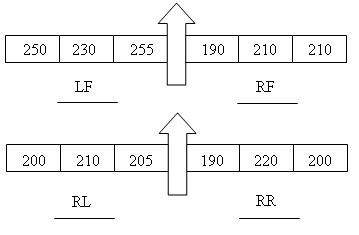|
From AutomotiveArticles.com Tech Check Learning to understand the process of reading tire temperatures can seem a little perilous to the inexperienced, but with the help of this article hopefully you will soon be able to use tire temperature as a very useful tool to determine:
The only trick to understanding tire temperatures is to realize that if one section of the tire is “working” harder than the other ones, its temperature will be higher. Traditionally, tire temperatures are measured at the inside edge, middle, and outside edge of the tire. It is critical to take temperature readings as soon as the car comes off the track otherwise the temperature across the surface of the tire will become more uniform as the whole tread surfaces cools.
A sample sheet of how to record your tire temperatures is shown below:
All of the temperatures are recorded as if you were looking down on the top of the car. Logically, the right front tire is on the right front of the sheet and the outside temperature of the front right tire is recorded on the outside. Following this pattern is important otherwise interpreting different sets of tire temperatures can become impossible.
Now to make sense of the temperatures in terms of suspension tuning,
Optimizing tire pressures Since we know that the hardest working portion of the tire will be the hottest, if the tire temperatures show that the middle of the tire is significantly hotter than the outside portions of the tread (a temperature variation of more than 10-15 degrees) the tire is over inflated. Too much pressure causes the center of the tire to bulge, resulting on most of contact patch being in the center of the tire. If you see temperatures like this, reducing tire pressure should normalize the temperature across the tread width.
Optimizing camber Using the same assumptions about tire work and temperature relationships, we can learn about camber settings. If the outside of a tire is the hottest portion, it means that the car does not have enough negative camber. The lack of (negative) camber means that in turns the car is riding on the outside of the tire causing it to work the hardest. To correct this, simply dial in more static negative camber. The result will be more evenly distributed tire temperatures, a car that won’t push through turns, and more than likely - quicker lap times.
Overheating the tires This is fairly straightforward; the tire temperature will let you know if you are overheating your tires. While this is fairly intuitive, most people don’t check tire temps. For the $80 bucks it costs for a pyrometer, there is no reason not to ensure you aren’t going to kill a brand new $250 a piece set of S-03 pole positions in four laps.
Tuning the chassis Tire temperatures can be a very useful tool in determining flaws in the suspension set up a vehicle. For instance say a car is running too hot on the front left tire (front wheel drive car). Not only will the tire not survive, but if there is not another tire compound available, the suspension tune must be changed to compensate. On this front wheel drive car, if the left tire is that hot, chances are that the driver is spinning that tire exiting turns. Modulating the throttle is one way to correct this problem although, an under steering chassis will push the car through the turn allowing the tire to spin. By changing spring rates or roll stiffness (sway bars) a little more over steer can be dialed in, letting the car rotate better in turns and saving the left front tire.
Of course tire temperatures are not the end all be all of suspension analysis, but because pyrometers can be had for fairly cheap it is a good way for people just getting into tuning their suspensions to get their feet wet and set their car up to handle better all at the same time. © Copyright 2004 by AutomotiveArticles.com |
